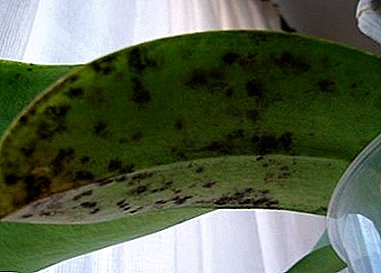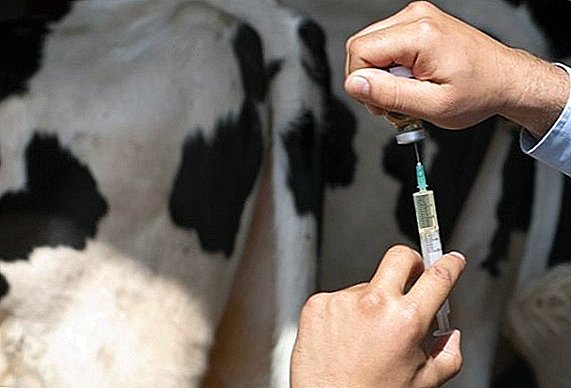 In modern veterinary medicine, antibiotics are one of the most common groups of biologically active substances used by humans. For more than a decade, these compounds have helped breeders deal with many ailments, which increases not only the efficiency of farming, but also the profitability of the cattle-breeding farm, including in breeding cattle. In this article we will look in detail at the main types of veterinary antibiotics, as well as the principles of their safe use in the treatment of livestock.
In modern veterinary medicine, antibiotics are one of the most common groups of biologically active substances used by humans. For more than a decade, these compounds have helped breeders deal with many ailments, which increases not only the efficiency of farming, but also the profitability of the cattle-breeding farm, including in breeding cattle. In this article we will look in detail at the main types of veterinary antibiotics, as well as the principles of their safe use in the treatment of livestock.
The value of antibiotics for cattle
Today, antibiotics in veterinary medicine occupy one of the leading positions in terms of industrial production. With their help, breeders around the world are struggling with a variety of infections, as well as use as additional feeding. This makes it possible to increase the activity of animal metabolism, as a result of which not only weight gain is observed in cows, but also an increase in the volume of end-products of animal husbandry.  In modern conditions, breeding animals without active antibiotic therapy is impossible. Industrial cattle breeding provides for keeping animals in close contact and often in a small area. The limited area, as well as freedom of movement, cause cattle to drastically reduce the protective functions of the body, therefore, without antibiotics, such animals often get sick and suffer from all sorts of pathologies.
In modern conditions, breeding animals without active antibiotic therapy is impossible. Industrial cattle breeding provides for keeping animals in close contact and often in a small area. The limited area, as well as freedom of movement, cause cattle to drastically reduce the protective functions of the body, therefore, without antibiotics, such animals often get sick and suffer from all sorts of pathologies.
Did you know? The first antibiotic that was released into industrial production is salvarsan. It happened in 1910 thanks to the German bacteriologist Paul Ehrlich.
In addition, keeping animals in cramped conditions contributes to the emergence of a particularly prosperous soil for the development of all kinds of infections. In this case, the periodic introduction into the body of highly active drugs is the only measure that can prevent the spread of dangerous diseases among the population. The need for such measures for the herd is also due to the natural need of the farm to rearrange animals. This causes excessive stress for the cows, which in the background of even a mild infection can cause the death of the livestock. To avoid this, antibiotics are used, which are able to instantly stop such processes at the initial stages.  The effectiveness and feasibility of antibiotic therapy is invaluable for farms. Such drugs help to reduce the total cost of feed, and also almost completely avoid any losses for the industry. This leads to an increase in the efficiency of livestock breeding, as well as a positive effect on the overall profitability of production. As a result, it is possible to reduce the final price for livestock products for consumers, and this is one of the foundations that helps fight hunger around the world.
The effectiveness and feasibility of antibiotic therapy is invaluable for farms. Such drugs help to reduce the total cost of feed, and also almost completely avoid any losses for the industry. This leads to an increase in the efficiency of livestock breeding, as well as a positive effect on the overall profitability of production. As a result, it is possible to reduce the final price for livestock products for consumers, and this is one of the foundations that helps fight hunger around the world.
But antibiotics have some features of use. To this kind of means should be approached with great care, since the irrational use of drugs adversely affects the body of animals. Do not forget that such tools are often undesirable for the use of pregnant cows. A surplus of antibiotics can cause a variety of fetal abnormalities and even death. The only exceptions are drugs based on natural ingredients (penicillins, macrolides, cephalosporins, etc.).
Important! Antibiotics are administered exclusively for the purpose of an experienced veterinarian, otherwise the uncontrolled use of drugs can have a detrimental effect on the body of animals.
Antibiotics for cows
Among the huge mass of all kinds of drugs, antibiotics occupy a leading position. Modern science knows more than 2 thousand compounds of this group, among which there are both natural and synthetic origin, which is associated with a high tolerance of living beings to such substances. But among them there is a narrow group of high-quality and inexpensive antibiotics that have not lost their activity for more than a year.
Tetracycline
A powerful antibacterial drug with a wide range of effects, based on natural ingredients. Receive them by extraction from the culture fluid of the bacterium Streptomyces aureofaciens.  Tetracycline is most often used to treat all kinds of infectious diseases that are resistant to penicillins and other inactive substances. Tetracycline is released in tablet form, the amount of the main active ingredient in one such tablet is 0.1 g. An antibiotic is used to treat salmonellosis, colibacillosis, pasteurellosis, pneumonia, and other infections that are susceptible to tetracyclines. The drug is administered orally, at a dose of 20 mg / specimen, every 12 hours. The duration of therapy is 5-7 days.
Tetracycline is most often used to treat all kinds of infectious diseases that are resistant to penicillins and other inactive substances. Tetracycline is released in tablet form, the amount of the main active ingredient in one such tablet is 0.1 g. An antibiotic is used to treat salmonellosis, colibacillosis, pasteurellosis, pneumonia, and other infections that are susceptible to tetracyclines. The drug is administered orally, at a dose of 20 mg / specimen, every 12 hours. The duration of therapy is 5-7 days.
Read more about the symptoms and treatment of colibacillosis and bronchopneumonia of calves.
Penicillin
Antimicrobial drug of a wide range of effects. An agent is used to combat bacterial invasions caused by bacteria of the genera Bacillus, Neisseria, Pasteurella, Streptococcus, Staphylococcus, etc. The preparation is obtained by extracting individual compounds from the culture fluid of mold fungi of the genus Penicillium. Penicillin is produced in the form of white crystalline powder of potassium and benzylpenicillin sodium salt (1000000 IU).  The agent is used for intramuscular or intravenous injections — to do this, the powder is dissolved in sterile distilled water or 0.5% novocaine solution. The drug is administered 4-6 times a day, a single dose of benzylpenicillin for adults is from 3000 to 5000 U / kg of body weight, for young animals - about 5000 U / kg of body weight. The duration of therapy is 5-6 days, but with excessively aggressive infections, it is prolonged to 7-10 days.
The agent is used for intramuscular or intravenous injections — to do this, the powder is dissolved in sterile distilled water or 0.5% novocaine solution. The drug is administered 4-6 times a day, a single dose of benzylpenicillin for adults is from 3000 to 5000 U / kg of body weight, for young animals - about 5000 U / kg of body weight. The duration of therapy is 5-6 days, but with excessively aggressive infections, it is prolonged to 7-10 days.
Did you know? Penicillin was accidentally discovered in 1928, during one of the experiments of the world famous British bacteriologist Alexander Fleming.
Streptomycin
Bacteriostatic drug of natural origin. Its components are isolated from the culture fluid of the bacterium Streptomyces globisporus.
It is used for pathogenic microorganisms of animals that cause mastitis, pneumonia, meningitis, leptospirosis, tularemia, diplococcal infection, endometritis, endocarditis, sepsis, campylobacteriosis, actinomycosis and other infectionssensitive to streptomycin sulfate.  The drug is produced in the form of white sterile powder used for deep intramuscular, intraperitoneal, intraperitoneal, intracavitary, intrauterine injections, as well as externally.
The drug is produced in the form of white sterile powder used for deep intramuscular, intraperitoneal, intraperitoneal, intracavitary, intrauterine injections, as well as externally.
The drug is administered 2 times a day, morning and evening. To do this, streptomycin is dissolved in sterile distilled water or 0.5% solution of novocaine. A single dose for adults is 5 mg of streptomycin sulfate / kg body weight, for young animals - about 10 mg / kg body weight. The total duration of therapy is from 4 to 7 days.
Learn more about the treatment of mastitis (purulent), leptospirosis, endometritis, bovine actinomycosis.
Ceftiocline
Cephalosporin antibiotic with a wide range of effects. The drug is a homogeneous liquid suspension of yellow or light brown hue. Ceftioclin is used to treat endometritis and cattle infections in cattle, as well as various respiratory infections.caused by the defeat of the organism by bacteria of the genera Pasteurella, Haemophilus, Streptococcus, Escherichia, Fusobacterium, Bacteroides.  Enter the tool subcutaneously or intramuscularly no more than 1 time per day. A single dose for livestock is 1 ml of the drug / 50 kg of body weight of the animal. The duration of therapy for diseases of the respiratory tract leaves from 3 to 5 days, but if necessary, therapy is prolonged until the acute symptoms of the infection disappear.
Enter the tool subcutaneously or intramuscularly no more than 1 time per day. A single dose for livestock is 1 ml of the drug / 50 kg of body weight of the animal. The duration of therapy for diseases of the respiratory tract leaves from 3 to 5 days, but if necessary, therapy is prolonged until the acute symptoms of the infection disappear.
Read also about the diseases of cows: hypodermatosis, chlamydia, brucellosis, teliasiosis, babesiosis, dictyocaulosis, acidosis, leptospirosis, rabies, EMCAR, clostridiosis, smallpox, bursitis, allergies.
Amoksisan
Active semisynthetic antibiotic, which belongs to the penicillin group. It is obtained by extraction of individual components from the culture fluid of mold fungi of the genus Penicillium and their further modernization in the laboratory.  Amoxisan is a liquid suspension of a yellowish tint (sometimes with a slight white precipitate). Amoxisan is used to combat a variety of infectious lesions in the organs of the respiratory tract, gastrointestinal tract, reproductive system, urinary tract, joints and soft tissues. Introduce the drug by intramuscular or subcutaneous injections, with a calculation of 0.1 ml / kg body weight. Apply the remedy once, but if necessary and to fix the results after 48 hours, repeat the injection.
Amoxisan is a liquid suspension of a yellowish tint (sometimes with a slight white precipitate). Amoxisan is used to combat a variety of infectious lesions in the organs of the respiratory tract, gastrointestinal tract, reproductive system, urinary tract, joints and soft tissues. Introduce the drug by intramuscular or subcutaneous injections, with a calculation of 0.1 ml / kg body weight. Apply the remedy once, but if necessary and to fix the results after 48 hours, repeat the injection.
Did you know? The world's first semi-synthetic antibiotic was released in 1961 by the British pharmaceutical holding Beecham. This is a world famous drug ampicillin, which is widely used by medicine to this day.
Gentam
Semisynthetic broad-spectrum antibiotic, relating to the combined drugs of penicillin nature. It is obtained by modifying natural antibiotics secreted by mold fungi of the genus Penicillium. Gentam is a clear suspension for injection.
 The drug inhibits a huge number of gram-positive and gram-negative bacteria, therefore it is quite widely used to combat various infections of the respiratory tract, gastrointestinal tract, urinary system, joints, with point lesions of the skin and tissues, as well as with necrobacteriosis and mastitis.
The drug inhibits a huge number of gram-positive and gram-negative bacteria, therefore it is quite widely used to combat various infections of the respiratory tract, gastrointestinal tract, urinary system, joints, with point lesions of the skin and tissues, as well as with necrobacteriosis and mastitis.
Enter the tool 1 time per day subcutaneously or intramuscularly, with a calculation of 0.1 ml / 10 kg of animal weight. The duration of therapy is from 2 to 5 days, but, if necessary, it is prolonged.
Check out the cattle vaccination scheme.
Oflosan
Antimicrobial and antimycoplasma agent of a wide spectrum of exposure, belonging to the group of fluoroquinolones. Oflosan actively suppresses the development of a variety of pathogenic microorganisms, including bacteria of the genera Escherichia, Enterobacter, Salmonella, Shigella, Klebsiella, Proteus, Pseudomonas, Campylobacter, Haemophilus and Staphylococcus. Oflosan is a liquid of a dark yellow or light yellow shade (with long-term storage a slight turbidity of the liquid is allowed, which disappears after agitation).  Use the tool to combat a variety of infections of the gastrointestinal tract, respiratory, urinary system, with arthritis, colibacteriosis, streptococcosis, salmonellosis, peritonitis, septicemia, necrotizing enteritis and other ailments. Apply the drug orally, 1 time per day, with a calculation of 0.5 ml / 10 kg weight of the animal. For salmonellosis, mixed and chronic infections, 1 ml of the drug is dissolved in 1 liter of water and used for feeding livestock throughout the day. The duration of treatment with oflosan is from 3 to 5 days.
Use the tool to combat a variety of infections of the gastrointestinal tract, respiratory, urinary system, with arthritis, colibacteriosis, streptococcosis, salmonellosis, peritonitis, septicemia, necrotizing enteritis and other ailments. Apply the drug orally, 1 time per day, with a calculation of 0.5 ml / 10 kg weight of the animal. For salmonellosis, mixed and chronic infections, 1 ml of the drug is dissolved in 1 liter of water and used for feeding livestock throughout the day. The duration of treatment with oflosan is from 3 to 5 days.
Read also about the symptoms (cough, diarrhea) and diseases of calves: white muscle disease, rickets, dyspepsia, umbilical hernia.
Efikur
A powerful antibiotic that belongs to the 4th generation cephalosporins. The drug has a powerful bacteriostatic effect on pathogenic bacteria of cattle. Based on natural antibiotics secreted from the culture fluid of bacteria Cephalosporium acremonium.  Efikur is a homogeneous white suspension or solution with a slight yellowish tinge. The drug is used to treat a wide range of respiratory infections, as well as to combat postpartum metritis complicated by bacterial infections. Efikur is administered 1 time per day, by intramuscular injections, with a calculation of 1 ml / 50 kg body weight. The duration of such therapy is often from 3 to 5 days.
Efikur is a homogeneous white suspension or solution with a slight yellowish tinge. The drug is used to treat a wide range of respiratory infections, as well as to combat postpartum metritis complicated by bacterial infections. Efikur is administered 1 time per day, by intramuscular injections, with a calculation of 1 ml / 50 kg body weight. The duration of such therapy is often from 3 to 5 days.
Important! It is strictly forbidden to administer ethers in animals that have a hypersensitivity to antibiotics of the beta-lactam group. Otherwise, the animal may develop anaphylactic shock.
Ceftiosan
Highly active bacteriostatic agent, which belongs to the drugs of the cephalosporin group. Ceftiosan has a natural origin, the main active compounds of the product are isolated from the culture fluid of the bacteria Cephalosporium acremonium. In appearance, the medicine has the form of a suspension, with a characteristic light yellow shade.  Ceftiosan has a strong antibacterial effect on a wide group of pathogenic microbial strains that cause a variety of respiratory ailments, as well as necrobacteriosis and endometriosisincluding representatives of the genera Streptococcus, Actynomyces, Staphylococcus, Salmonella, Escherichia, Pasteurella, Haemophilus, Actinobacillus, Klebsiella, Citrobacter, Enterobacter, Bacillus, Bacteroides, Proteus and Fusobacterium. Ceftiosan is used as an injection fluid for intramuscular administration. Enter the tool no more than 1 time per day, with a calculation of 1 ml / 50 kg weight of the animal. With respiratory ailments, the duration of such therapy is from 3 to 5 days, with necrobacteriosis - no more than 3 days, with endometriosis - about 5 days.
Ceftiosan has a strong antibacterial effect on a wide group of pathogenic microbial strains that cause a variety of respiratory ailments, as well as necrobacteriosis and endometriosisincluding representatives of the genera Streptococcus, Actynomyces, Staphylococcus, Salmonella, Escherichia, Pasteurella, Haemophilus, Actinobacillus, Klebsiella, Citrobacter, Enterobacter, Bacillus, Bacteroides, Proteus and Fusobacterium. Ceftiosan is used as an injection fluid for intramuscular administration. Enter the tool no more than 1 time per day, with a calculation of 1 ml / 50 kg weight of the animal. With respiratory ailments, the duration of such therapy is from 3 to 5 days, with necrobacteriosis - no more than 3 days, with endometriosis - about 5 days.
Livestock breeders will be useful to learn about diseases of cattle: diseases of the udder, hooves and legs, joints.
Amoxicillin
Semisynthetic antibiotic drug from the group of penicillins, which has a wide range of effects. It is prepared with the help of laboratory modification of natural bactericidal agents secreted by the fungi of the genus Penicillium in the course of their vital activity.  It is an amoxicillin oily liquid with a characteristic yellowish tinge. The tool is actively used to treat a variety of invasions caused by a wide group of both gram-negative and gram-positive bacteria, including infections of the gastrointestinal tract, joints, urogenital system, respiratory organs, soft tissues, etc.. Use the drug once, for subcutaneous or intramuscular injections, with a calculation of 1 ml / 10 kg of animal weight. If necessary, the agent is re-administered, but not earlier than 48 hours.
It is an amoxicillin oily liquid with a characteristic yellowish tinge. The tool is actively used to treat a variety of invasions caused by a wide group of both gram-negative and gram-positive bacteria, including infections of the gastrointestinal tract, joints, urogenital system, respiratory organs, soft tissues, etc.. Use the drug once, for subcutaneous or intramuscular injections, with a calculation of 1 ml / 10 kg of animal weight. If necessary, the agent is re-administered, but not earlier than 48 hours.
Important! The combined use of 2 or more groups of antibiotics is allowed in exceptional cases and only under the supervision of a veterinarian.
When can I drink milk after antibiotics?
Almost all known antibiotics are characterized by a fairly long stay in the body, including as derivatives of decay products. That is why these compounds quite successfully saturate almost all organs, tissues and physiological fluids, including milk. This is a natural norm, since it is this feature that provokes the high bacteriostaticity of antibiotics in relation to pathogenic microorganisms.
The period of excretion of such compounds often depends on the type of substance. Most penicillin compounds leave the body completely after 3-5 days, while complex synthetic drugs require about 14 days. However, if an animal has an organism that is excessively weakened by an infection, a decrease in the activity of the metabolism is observed against this background, which negatively affects the elimination of derivatives of antibiotics. That is why, according to general veterinary requirements, after active antibiotic therapy livestock products are not suitable for consumption for the next 20-25 days, since the last injection.  Antibiotics are an important group of drugs, without which the management of modern cattle breeding is not possible. These drugs have a powerful antibacterial effect on a variety of infections and help to stop the epidemic at the initial stages. But such means should be administered to animals exclusively under the supervision of experienced veterinarians, otherwise the treatment therapy will cause a worsening of the general state of animal health.
Antibiotics are an important group of drugs, without which the management of modern cattle breeding is not possible. These drugs have a powerful antibacterial effect on a variety of infections and help to stop the epidemic at the initial stages. But such means should be administered to animals exclusively under the supervision of experienced veterinarians, otherwise the treatment therapy will cause a worsening of the general state of animal health.












